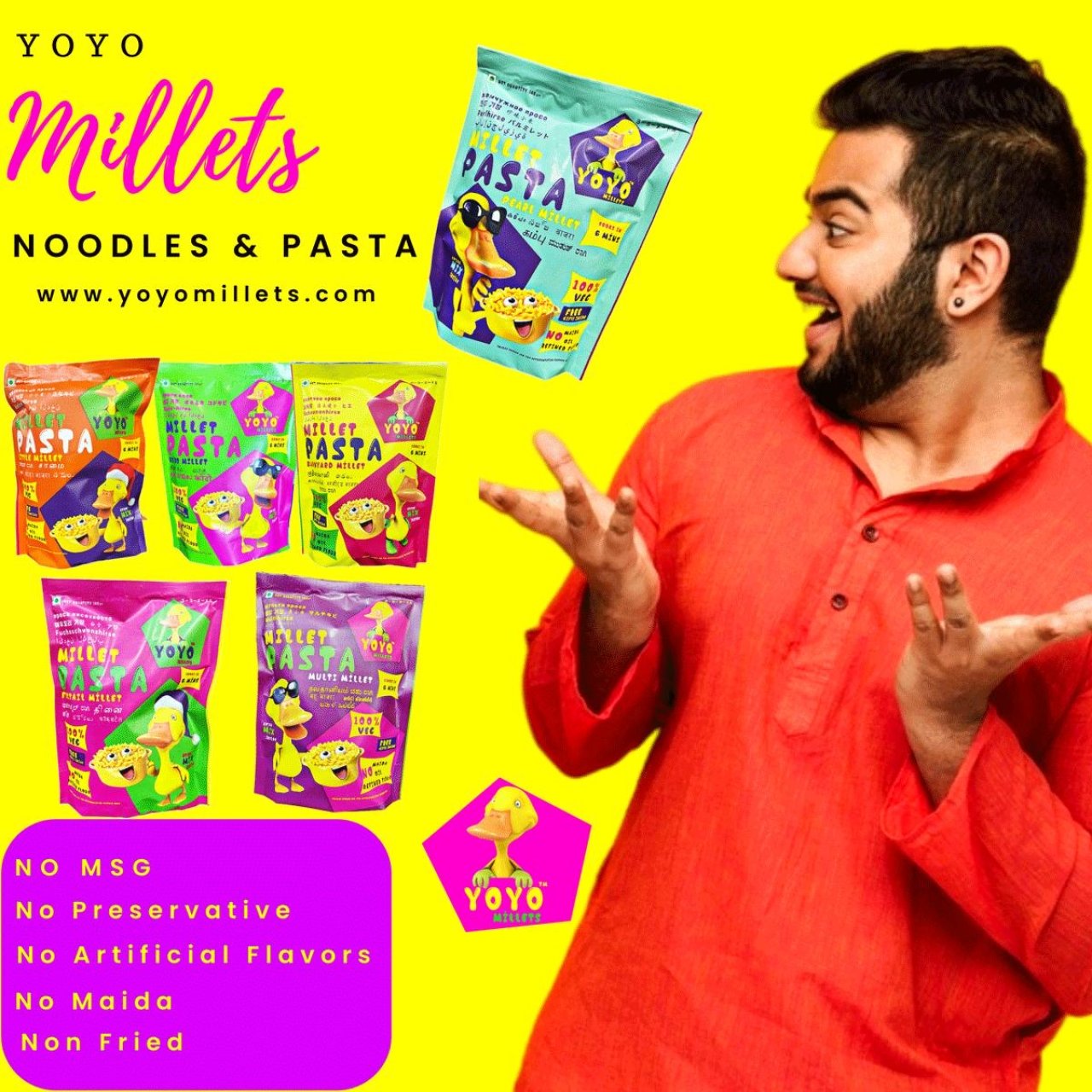Pearl Millet Pasta

Pearl Millet Pasta
Pearl millet pasta are a type of noodle made from pearl millet flour. Pearl millet, scientifically known as Pennisetum glaucum, is a nutritious grain that is widely grown in Africa and Asia. It is known for its resilience in arid and semi-arid environments and its rich nutritional profile.
Here are some key points about pearl millet pasta:
Gluten-Free: Pearl millet pasta are naturally gluten-free, making them suitable for people with celiac disease or gluten sensitivities.
Nutrient-Rich: Pearl millet is a good source of nutrients such as carbohydrates, protein, dietary fiber, vitamins (especially B vitamins like niacin and thiamine), and minerals (such as iron, magnesium, phosphorus, and potassium). These nutrients are important for overall health and well-being.
Low Glycemic Index: Foods made from pearl millet have a lower glycemic index compared to some other grains, which means they can help in managing blood sugar levels. This can be beneficial for individuals with diabetes or those looking to control their blood sugar levels.
Culinary Uses: Pearl millet pasta can be used in a variety of dishes, similar to other types of pasta. They can be used in soups, stir-fries, salads, and other recipes that call for pasta.
Versatile: Pearl millet pasta can be a versatile addition to a gluten-free diet, offering a different texture and flavor compared to traditional wheat-based pasta.
Health Benefits: Consuming pearl millet pasta as part of a balanced diet can contribute to overall health due to their nutrient content and gluten-free nature.
When choosing pearl millet pasta, it's important to look for products made from high-quality ingredients and minimal processing to retain their nutritional benefits. As with any food product, pearl millet pasta should be consumed as part of a balanced diet to reap their nutritional benefits.
Pearl millet, scientifically known as Pennisetum glaucum, is a nutritious grain that offers several health benefits. Here are some of the key benefits of consuming pearl millet:
Rich in Nutrients: Pearl millet is a good source of essential nutrients such as carbohydrates, proteins, dietary fiber, and various vitamins and minerals including iron, magnesium, phosphorus, and potassium. These nutrients are important for energy production, bone health, and overall well-being.
Gluten-Free: Pearl millet is naturally gluten-free, making it a suitable grain for people with celiac disease or gluten sensitivities.
Low Glycemic Index: Foods made from pearl millet have a lower glycemic index compared to some other grains. This means they can help in managing blood sugar levels and may be beneficial for individuals with diabetes or those looking to control their blood sugar levels.
Rich in Antioxidants: Pearl millet contains antioxidants such as phenolic compounds, which can help protect the body from oxidative stress and reduce the risk of chronic diseases.
Digestive Health: The dietary fiber content of pearl millet supports digestive health by promoting regular bowel movements and preventing constipation. Fiber also contributes to a feeling of fullness, which can aid in weight management.
Heart Health: Pearl millet contains nutrients like magnesium and potassium, which are important for heart health. Magnesium helps regulate blood pressure and supports muscle and nerve function, while potassium helps maintain healthy blood pressure levels.
Weight Management: Pearl millet is a low-calorie, nutrient-dense food that can be a part of a balanced diet aimed at weight management. The fiber content also contributes to a feeling of fullness, which can help in controlling appetite.
Easy to Digest: Pearl millet is considered easy to digest, making it suitable for individuals with sensitive digestive systems.
Incorporating pearl millet into your diet can be a healthy choice, especially if you are looking to diversify your grain intake, manage your weight, or follow a gluten-free diet. As with any dietary change, it's important to consume pearl millet as part of a balanced diet to reap its full health benefits.
Pearl millet, also known as bajra in India, is primarily used as a food grain, especially in regions where it is grown. Some of the major uses of pearl millet include:
Food: Pearl millet is a staple food in many parts of Africa and Asia, where it is used to make various traditional dishes. It is commonly ground into flour and used to make flatbreads, such as roti or bhakri, which are a staple in many Indian households. Pearl millet flour can also be used to make porridge, pancakes, and other baked goods.
Beverages: In some cultures, pearl millet is used to make traditional fermented beverages like beer or porridges.
Livestock Feed: Pearl millet straw and leftover grains after processing are used as fodder for livestock due to their nutritional content.
Traditional Medicine: In some traditional medicine systems, pearl millet is used for its purported health benefits. It is believed to have cooling properties and is sometimes used to prepare traditional remedies.
Soil Improvement: Pearl millet is also used as a cover crop and forage crop to improve soil fertility and prevent soil erosion in agricultural systems.
Overall, pearl millet is a versatile grain with various culinary and agricultural uses. It is valued for its nutritional content, especially in regions where it is a dietary staple.







